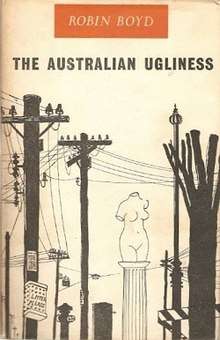The Australian Ugliness
 First edition | |
| Author | Robin Boyd |
|---|---|
| Country | Australia |
| Language | English |
| Publisher | F. W Cheshire, Melbourne |
Publication date | 1960 |
| Media type | Print (Paperback) |
| Pages | 229 pp |
The Australian Ugliness is a 1960 book by Australian architect Robin Boyd. Boyd investigates visual pollution in Australian aesthetic, in relation to architecture and the suburbs. In the text he coins the doctrine "featurism" to describe the state of Australian architectural design.
Whilst not entirely a tragedy for the Australian community, Boyd proposes that education in design, landscaping and architecture can be a means to resolve the ugliness he observed.
Summary
The book can be seen as an "attack", or criticism, on Australia's built landscape.
Boyd's three main criticisms stem from three ideas: the Australian obsession with "featurism"–a fixation on parts rather than the whole, the use of building materials and styles that are unsympathetic to the country's landscape/climate, and the culling of trees in order to "divert" drains, prevent leaf clogging and other immaterial issues. Boyd's belief that trees are not a feature, or a byproduct of design, but rather a fundamental landscaping necessity, something unrecognised by Australian homeowners and city planners who opt for low maintenance.
It also channeled the "cultural cringe", as well as drawing comparisons to the man-made post modernist landscapes of North America and to a lesser extent Europe.[1] Boyd's belief was that because Australia was in its infancy at the time of his critique, it had not developed a strong historic character like Europe, and thus its architectural landscape was a bombardment of confused style and mixed ideas.
Reception and influence
After the book's first publication, Boyd was criticised for being "unpatriotic" by the Australian mainstream press. As the years passed, the book became somewhat of a legacy and is now widely regarded as one of the most important books regarding Australian design, culture and architecture.
The book is now an influential best seller, opening up the debate about design, architecture and urban planning in the country. It has received various reprints and adjustments over the years.
In the following years, Boyd's book inspired derivative and reactionary works, ranging from Donald Gazzard’s more visual Australian Outrage (1966) and Look Here! Considering the Australian Environment (1968).